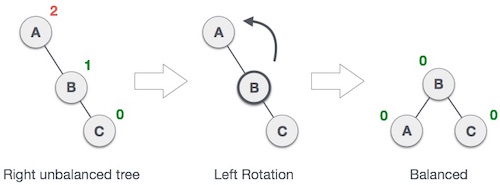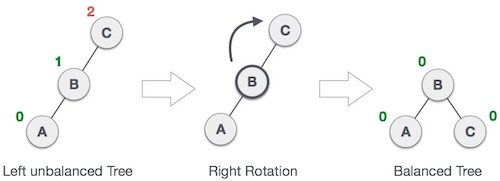AVLs
AVL trees
AVL Trees are sub classification of BSTs.
AVL Properties and Efficiency
-
Height(node) = max{Height(left), Height(right)} + 1
- Base cases: Height(leaf) = 0, Height(null) = -1
-
BalanceFactor(node) = Height(left) - Height(right)
-
AVLs store heights and balance factors to make calculations O(1) as opposed to O(n)
Definition of Unbalanced
- Node is unbalanced if
|BF| > 1 - Node is balanced if
BF = -1, 0, 1
Rotaions
Rotations are operations performed in AVL trees to maintain and restore balance.
In AVL trees, there are two fundamental types of rotations.
- Single rotation
- Left rotation

- Internet source: AVL Tree Insertion, Rotation, and Balance Factor Explained. Retrieved from https://www.freecodecamp.org/news/avl-tree-insertion-rotation-and-balance-factor/ (Accessed on May 24, 2023).
Pseudocode leftRotation(Node A) 1. Node B <- A's right child 2. A's right child <- B's left child 3. B's left child <- A 4. Update the height & BF of A 5. Update the height & BF of B 6. Return B - Right rotation

- Internet source: AVL Tree Insertion, Rotation, and Balance Factor Explained. Retrieved from https://www.freecodecamp.org/news/avl-tree-insertion-rotation-and-balance-factor/ (Accessed on May 24, 2023).
Pseudocode rightRotation(Node C) 1. Node B <- C's left child 2. C's left child <- B's right child 3. B's right child <- C 4. Update the height & BF of C 5. Update the height & BF of B 6. Return B
- Left rotation
- Double rotation
- Internet source: AVLs. AVL Rotations. Retrieved from Edx Data Structures & Algorithm (Accessed on May 25, 2023).
Leave a comment